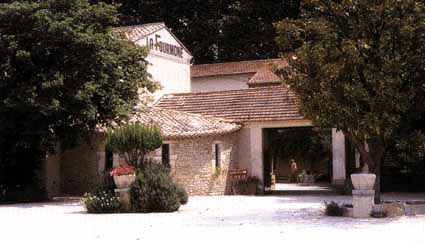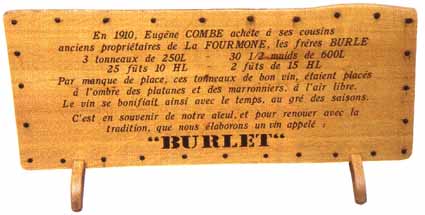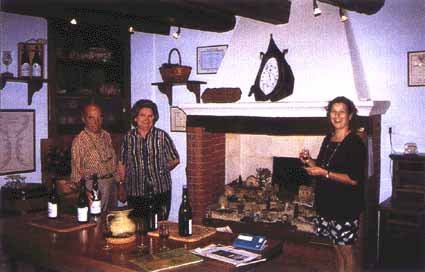



You are here: Home
   |

|
|
You are here: Home |
The old and the newIn 1990 I made my very first visit to a Vaucluse wine-producer - the Domaine la Fourmone. In the summer of 1998 I went back. This article contrasts its 300-year history with that of a somewhat newer concern.  The Domaine La Fourmone The old...I will never forget visiting the Domaine la Fourmone in the summer of 1990. That was my very first experience of tasting the wines of the Côtes du Rhône with the people who made them, and the start of an abiding interest that has taken me to some beautiful places, introduced me to some wonderful people and enabled me to drink glorious wines at, frankly, silly prices. Meeting Roger Combe, whose very English-looking name I had seen on so many wine labels at home, was particularly memorable. Far from being English, Roger Combe (pronounced ’Ro-jay Commb’, with the final ’b’ voiced quite strongly) is not only French, but a Provençal through and through - a noted poet in the ancient language of the region, and something of a historian. He has researched in great detail the backgrounds of the properties and families which have come together to form EURL Roger Combe et Fille as it is today.  This elegant wooden display board reminds visitors of the domaine’s long history He traces the name ’Fourmone’ right back to its Latin roots in ’frumentum’ (wheat) and has found its derivative, ’Formont’ as a surname in local baptism records from as long ago as 1635. The boundaries of the domaine (which is in the commune of Vacqueyras) were established as long ago as 1700, though it was first recorded as la Fourmone as ’recently’ as 1882. In 1910 it passed from the Burle brothers to their cousin, Eugène Combe, who had been farming it as a tenant for 20 years. A second property, the Domaine l’Oustau Fauquet in the neighbouring commune of Gigondas, came into the family business when it was inherited by Roger Combe’s wife. In June 1998 we went back, to taste, to buy and to talk with Monsieur Combe and his daughter, Madame Marie-Thérèse Combe, who now manages the business. Sadly, her father’s failing eyesight has forced him to retire as both an active vigneron and a poet, though he is still very much a presence in and around the cave de dégustation. La Fourmone is on the D8, just outside Vacqueyras in the direction of Bollène (’phone 04.90.65.86.05). It is one of the most visually enticing domaines in the area. Its beautifully-kept yard contains many well-preserved mementoes of bygone days, and the buildings themselves are protected from the fierce sun by a thick covering of hanging creeper. Memories tend to be unreliable, but the cave was almost as I remembered it - a cool, dimly-lit refuge from the searing midday heat, in which both the taste and the colour of the wines could be appreciated to the full. The wines themselves are also enticing - not least because the poet has given them such delightful names. They are excellent examples of their types and, as always when you buy direct from the producers in the Côtes du Rhône, the prices are extraordinarily low. At the time of our visit, the Réserve des Muses red and the Rosé des Demoiselles were 1996 wines (both AOC Côtes du Rhône). They cost 27 francs and 29.50 francs a bottle respectively. The Cuvée Fleurantine is a white Vacqueyras. The 1997, which won a gold medal at Mâcon, is 40 francs, and the oak-aged 1996 is 45 francs. (The word Cuvée is one which we wine-drinkers see on labels every day and take for granted. On this visit I learned that a cuve is a fermentation vat, and a cuvée is a vatful - a single batch of wine.) There are three Vacqueyras reds: the 1995 Trésor du Poète at 38 francs; the 1996 Mâcon silver medal winner, Sélection Maître de Chais (I also learned that un chais or chai is a shed for storing wine) at 40 francs; and the Cuvée des Ceps d’Or, from old vines and justifiably marked exceptionnel at 48 francs. The two Gigondas reds from l’Oustau Fauquet are the 1994 Cuvée Traditionelle at 45.50 francs and the 1993 Cuvée Cigaloun (Provençal for cicada, the insect whose rhythmic rasping tells even the most navigationally-challenged traveller that he is in The South), which won a silver medal in Paris, at a princely 49.50 francs. Unlike many proprietors, Mme Combe didn’t share my enthusiasm for buying wines en vrac. La Fourmone and l’Oustau Fauquet are prestigious properties whose Vacqueyras and Gigondas marques are in the top drawer of Rhône wines, and the price-list offers only one bulk wine, hidden on the other side of the sheet from the serious stuff. Cuvée Familiale, a 12.5% red, costs 9 francs a litre - equivalent to 71p a bottle at 9½ francs to the pound. You can also buy it ready-bottled at 15.50 francs (£1.63), which gives you a useful insight into the cost of bottling, corking and labelling - more than that of the wine itself at this price-level. However, we found several other bulk wines available when we visited: a Cuvée Familiale 12% rosé at 12 francs a litre (95p a bottle); a 14% red Vin de Table Supérieur at 15 francs a litre (£1.18 a bottle); and a 13.5% red Côtes du Rhône at 17 francs a litre (£1.34 a bottle). This last is presumably left over from bottling the Réserve des Muses for next year’s market. We decided to go for the top-of-the-range with ten litres of the Côtes du Rhône. After only a few months in bottle, this is excellent. Despite the emphasis on vrac in these articles, we also treated ourselves to three bottles each of the superb Cuvée Traditionelle Gigondas and Sélection Maître de Chais Vacqueyras, both real bargains. We shared the cave de dégustation with Annie and Jim Davidson, proprietors of the Hôtel Le Clement V at Roquemaure, a medieval village among the vineyards of Châteauneuf du Pape, Tavel and Lirac, who were buying wines for their restaurant. Any hotel that takes this much trouble over its wines must be worth a visit, and we decided then and there to stop off there when we got round to tasting on the other side of the Rhône.  Roger and Marie-Thérèse Combe with Annie Davidson in the cave de dégustation We finally got round to doing this at the end of August 1999, and had a thoroughly enjoyable three days at the hotel. The building was a delightfully cool refuge from the fearsome heat we encountered (abnormal even that far south and at that time of year), as was its large swimming pool. The two dinners we ate on the covered terrace were excellent, and the Lirac rosés and reds we sampled were delightful. Roquemaure itself is fascinating, and makes a marvellous base for exploring the area. The fact that Jim is Scottish (Annie is French) makes their hotel even more attractive for linguistically challenged travellers. ...and the newMuch closer to ’home’ (the village of Caromb, where we were staying), is a domaine with a somewhat shorter history than that of La Fourmone - it has been producing its own wines for just seven years. These are Côtes du Ventoux, on paper a far less grand appellation than either Vacqueyras or Gigondas, but they are very good indeed. Last year, we gave a bottle of the top-of-the-range red, costing just 30 francs, to a restaurateur friend of ours, a serious connoisseur with a huge cellar full of top-vintage Burgundies, Clarets, Champagnes and Ports. He was so impressed that he has been ordering it for his restaurants ever since. The short history of Le Domaine Chaumard makes a delightful story. Gilles Chaumard’s parents are pépiniéristes, whose nursery sells plants and trees to gardeners. They had been growing grapes for many years, but these were sent to the cave co-opérative in Caromb, where they were mixed with those of many other growers to produce sound but unexciting generic red, white and rosé wines. They had a dream - that Gilles would become a real vigneron, making wines in his own cave that would express the true quality and character of their land and its grapes. So Gilles went to college in Montpellier, where he gained his Diplôme Nationale de l’Oenologie. While there, he met Christine, a native of Avignon, doing the same course. After qualifying, they married, and they opened their cave in 1991, at about the time their first son, Robin, was born. Now, at 7, his mother describes him as ’a good taster who knows his wines’. His four-year-old brother, Thibaud, ’just likes to drink them’! Le Domaine Chaumard, on the Route d’Aubignan just outside Caromb (’phone 04.90.62.43.38), is beautifully kept, with a wonderful old olive-tree (a great status symbol in Provence) to mark the entrance and a welcoming cave de dégustation adjoining the large, cool production area. Ironically, Gilles and Christine themselves live next-door to Caromb’s cave co-opérative, the Caveau St-Marc, because his parents still occupy the family house. The 15 hectares of vines produce 80,000 litres of vin de table and appellation contrôlée Côtes du Ventoux a year. Astoundingly, apart from the vendange (grape-picking) itself, when they employ a team of students, Gilles and Christine do all the work themselves. For them, vrac is an important part of the business - all their vin de table is sold in bulk, mostly prepacked in 10-litre bag-in-boxes - and they take it seriously. So, obviously, do their customers, because all the 1997 12% white (11 francs a litre or 87p a bottle) had been sold by May. Worse, when we asked our friends to bring us some more of the 13% red (also 11 francs) in September that had all gone too. The other vins de table are a 13% rosé (11 francs again) and a 12% red at an astounding 6.5 francs a litre (51p a bottle). The 12% red is a sound, well-balanced everyday glugging wine. The others are quite impressive after a few months in bottle, and for me the 13% red is on a par with the 14% one from the Domaine la Garrigue, described in the previous article, with a rich, velvety smoothness over a very full body. We both like it enormously - hence the request for some more! Whatever else we buy on our next visit, this wine will be high on our list. All the Côtes du Ventoux wines available when we visited were from 1997 (the 1996 red at 18 francs a bottle was sold out). The white was 23 francs, the rosé 22 francs and the basic red 20 francs. There were also two superior reds - Cuvée des Campagnolles at 22 francs (also available in magnums at 60 francs) and the Cuvée Réservée, in an impressive gold-printed bottle, at 30 francs. This, the most expensive, is equivalent to just £3.16 at 9½ francs to the pound. Our total purchase - ten litres each of 13% red and rosé in bag-in-box packages (charged at 20 francs each), plus six bottles each of Côtes du Ventoux white and Cuvée des Campagnolles - set us back just 530 francs, or about £55.80. With young Robin’s developing palate and little Thibaud’s enthusiasm, it looked as if the future of this new domaine and its excellent wines was already secure - for one more generation, at least. So we were heartbroken to hear on our next visit in early summer 1999 that little Thibaud had been killed in a car accident. If you take our advice and visit this excellent domaine, please be tactful. We hope that the worst of this dreadful shock has now passed, and wish the young famille Chaumard the success they deserve for their hard work and dedication. |
Personal site for Paul Marsden: frustrated writer; experimental cook and all-round foodie; amateur wine-importer; former copywriter and press-officer; former teacher, teacher-trainer, educational software developer and documenter; still a professional web-developer but mostly retired. This site was transferred in June 2005 to the Sites4Doctors Site Management System, and has been developed and maintained there ever since. 
|
|